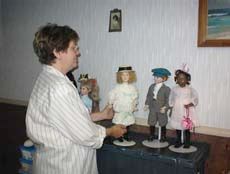|
The 24-inch porcelain doll
is just one of many lifelike examples of Bailey’s
talent and profession evident throughout her home
and business.
Even though Bailey’s natural
talent is evident, she didn’t attend art school and
never planned on being a business owner. What started
as a casual interest in antique doll collecting 20
years ago turned into a thriving business for the
Lincoln woman, who owns and operates Lincoln Mold
Co., Inc. Bailey, who sells dolls, doll molds, kits
and clothes patterns, operates her business from her
home at 127 Crestwood St.

[Betty's 24-inch porcelain doll]
“I enjoy it. It’s really
held my interest. I’ve got so many ideas. I know some
artists get tired and quit because they run out of
ideas,” she said. But Bailey is inspired to create
a new doll when she sees the face of a friend’s child
or comes across an interesting picture in a magazine.
Soulful eyes, a freckled nose or round face are a
few of the features that may prompt her back to her
work space in the garage to begin working on a new
doll mold. She likes “freckles, big noses, interesting
eyes and character,” she says, and the expressions
and features of the faces of her doll creations prove
it.
And even though her collecting
is what started it all, she now says she doesn’t consider
herself a doll collector. She receives her pleasure
not from accumulating hundreds of dolls to line the
walls of her home but rather from making dolls and
molds for other people to create their own versions
to enjoy. Even though a Victorian woman sits next
to the sofa, a baby doll sits on an antique desk in
the dining room, and one of her latest doll creations,
featuring a satin wedding dress, sits casually on
the floor – all proof of her passion – she has a very
casual attitude about her talent and work.
A
Louisiana native, she has lived in Lincoln about 10
years. Although she attended college and majored in
education, she quit school to become a homemaker after
getting married and having two sons. While living
in upstate New York in 1980, she developed an interest
in antique dolls. That was the beginning of an evolving
love and connection with all aspects of doll-making.
“When you collect, you read
about them (dolls) and how they were made. Of course,
back then, they were made by craftspeople but they
were truly art. I wanted to re-create what they did.
I just took off on my own,” she said.
(To top of second column in this article) |
Armed with more determination than knowledge, she
says she “just hacked my way through the underbrush,”
to learn how to make doll molds. With no instruction
book to be found, or formal training, Bailey set out
to make her first doll mold and soon found it wasn’t
easy. “Of course when you learn like that, everything
that could go wrong, does go wrong. That’s how I got
started. After I learned how to do it, then I started
making limited edition dolls,” she said.
She began selling her dolls
at craft shows and slowly building her business, while
also making and selling plaster molds, from which
porcelain doll bodies are made.
“There’s not anything written
about how those early craftspeople made those dolls.
Just a nugget here and a nugget there. But I know
enough about it, I can pick up on those nuggets,”
she said.
A
completed doll can sell for up to a few thousand dollars,
while the mold sets usually cost between $200 and
$266. She has designed and created several popular
kinds of dolls, from her “Front
Porch Children” collection – depicting small children
with names like June
Bug, Pi
Biedy, Bubba
and BJ
Kendrick – to her “Fashion
Plate” collection, depicting Victorian women dressed
in their 19th century finery. Fashion plates, which
were the “fashion photography” of that period, were
works of art reproduced from engraved copper plates
and hand-colored. The sculpted women dolls show the
stylized features considered fashionable in the 19th
century, including long necks; smooth, rounded shoulders;
small, pinched waistlines; and graceful hands. The
dolls are draped in full, pleated dresses and many
are holding parasols.

[Betty displays more of her artwork.]
But Bailey said she has
no favorites – she prefers whichever one she is working
on at any given time.
One of her sons helped her
get the business up and running, but he has since
married and moved to another state. Her late husband
also helped her with aspects of the business, such
as traveling out-of-state to doll shows. Now she runs
the business on her own and has no plans to retire.
Her garage workshop, once
the site of all the mold making, still holds boxes
of mold materials, although the molds are now made
off-site. Her basement office is filled with shelves
of doll clothes patterns and doll catalogs advertising
her work. Although she says she now sells more clothing
patterns than molds, her business continues to grow,
and she has plans for a website, from which she hopes
to reach new customers and markets.
[Penny Zimmerman-Wills] |



